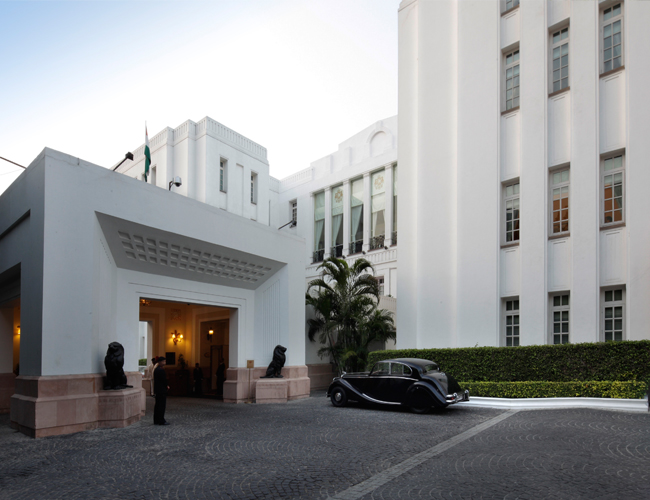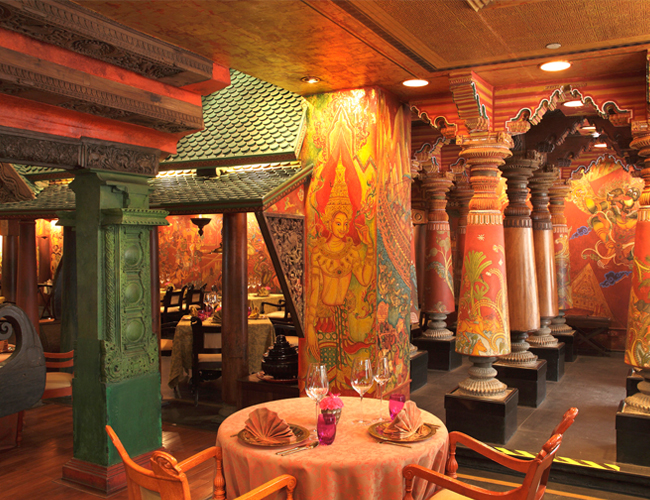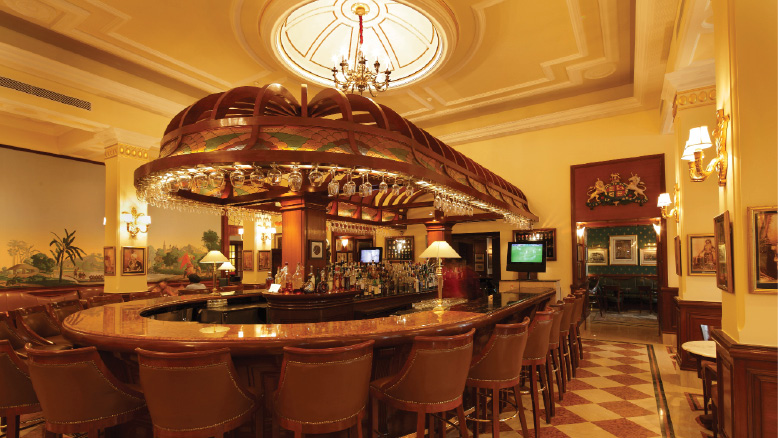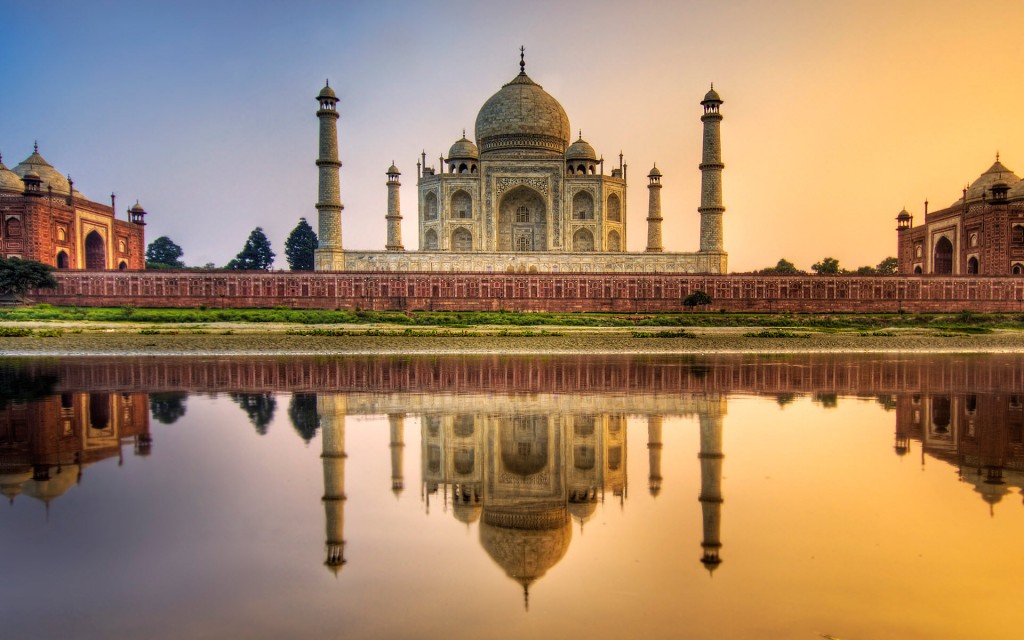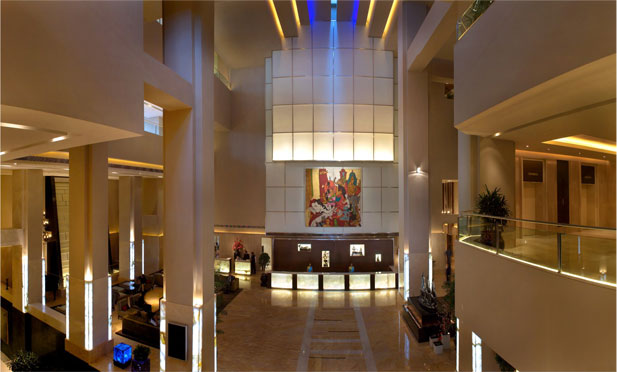The Imperial is a legend that offers a unique experience embracing facets of India’s history, and stands witness to the birth of the capital city of New Delhi. I decided to make this my first stop while traveling to Delhi en route to the Taj Mahal. Built in 1931, the hotel is known for its contemporary colonial style. As New Delhi’s landmark Hotel, it is located on Janpath, steps away from the renowned shopping district and major attractions of the city. Within the hotel, and heralded as one of the top ten restaurants in the world by Condé Nast Traveler, The Spice Route mesmerizes all the senses, enrapturing guests with its artistic wooden columns and romantic seating areas. The story of the spice route is told through murals surrounding the walls. The Spice Route was deemed one of the best Asian restaurants by Zomato Food Guide in 2013. I was interested in finding out more about this highly publicized restaurant.
The ImperialDesigned by Rajeev Sethi, the celebrated cultural czar of India, The Spice Route reflects the journey of spices from the Malabar Coast in Kerala through Sri Lanka, Malaysia and Indonesia to Thailand and Vietnam. The Restaurant, that was seven years in the making, is completely hand painted with vegetable and flower dyes by mural painters brought in especially from a temple in Guruvayur in Kerala with a tradition dating back to 3000 years.
The Spice Route Courtyard transports the guests to the wonderful world of Southeast Asia. Adorned with traditional Thai sculptures from the Chiang Mai region in northern Thailand and a picture-perfect pond with floating candles, the far end of the pavilion has traditional Khantok seating for six under an Oriental pagoda. This is where I was seated to enjoy the serenity and splendour. The maître d’ explained the “journey of life” recounted in the artwork of the restaurant, while I reviewed the menu. This menu was highlighted by gems such as Kung Nang Phad Khing (Stir-fried lobster with ginger and Thai black mushrooms, served in the shell) and Phad Phak (Chef’s special stir-fried baby bok choy with black mushrooms, flavored with soya bean paste). I tried these and found them to be served to perfection.
After dinner, I ventured to the 1911 Bar, with its soft Montana leather chairs, stained glass roof and wood paneling, the bar features over 500 varieties of beverages and music plays to its guests’ moods. It boasts two stunning private rooms: the ‘Hardinge Room’ and the ‘Lutyens & Baker Room’ offering seclusion and the highest level of discrete service. The walls in the Hardinge Room are adorned with attire of various battalions during the British Raj and the most coveted Victoria Cross, the highest gallantry award in the British Army, the one and only existing in the city. It is feature such as this that has gained “The Imperial” the prestigious World Luxury Hotel Award, and has been chosen as the “Best Luxury Hotel in India for 2013”, and among the top hotels in the country for the fourth year in a row. At the end of the evening, I was able to relax and prepare for my upcoming trip to the Taj Mahal the following morning.
Getting to Agra from Delhi when visiting the Taj Mahal is best accomplished with a personal driver and guide. To travel any other way will simply mean missing out on so much of Delhi’s urban mass that holds so much character and intrigue of the city’s dynamic character. The Taj Mahal itself has been in the news lately for many reasons, including the announcement of Maulik Pancholy’s engagement in January, the book release of the emperor Shah Jehan’s Black Taj Mahal by Iftakhar Nadime Khan, and the famous attempted auction of a diamond replica of the mausoleum. Each of these headlines has brought the world heritage site to the forefront.
I spent several days in Delhi and the Taj Mahal was certainly one of my favorite places. The mansion is so breathtaking that no words can describe the beauty of it. The architecture is completely stunning and the love story behind the historic site is beautiful. The entrance fee of 750 rupees per person includes a bottle of water, shoe covers, a map and the bus ride to the Taj in an electric car. I managed to snap some photographs of the palace in the afternoon when the sky was blue, making the pictures more beautiful.
It was such an awe-inspiring experience to enjoy the sunset at this beautiful palace and to wander through every corner and explore its beauty. I could hardly believe that this monument was more than 361 years old. We might have lost some features to time and some features are hidden purposely due to security but, on the whole, the building inspires a sense of grandeur. Later, I saw the Taj Mahal at sunset from Mehtab Bagh, a Persian-style garden which boasts incredible views as the sky was quite clear. Upon leaving Agra late in the evening, I was satisfied that I had explored Shah Jahan’s universe and vision of the world, inspired by love and shaped to perfection. I was convinced that the Taj Mahal immortalizes one man’s love for his wife and the splendor of an era.
Venturing a short 14 minutes’ walk from the Imperial was the Lalit Hotel. I chose to move to this hotel after my two nights’ stay at The Imperial. Upon arriving at the hotel, I was very impressed. The decor was modern, clean and comfortable. Service was personable, prompt and professional. I ate in the Northern Indian restaurant and had a very good meal, eaten traditionally with my hands. The hotel staff always greeted me warmly whenever I ran into them. The room service and personal services were wonderfully quick and attentive. Food and beverages were delivered almost always within 10 to 20 minutes and small details impressed me. For example, if I ordered tea, I received some biscuits in a little jar to go with it. Perfect!
Because of my schedule, I never could experience the dinner buffet, but the breakfast and lunch had a huge variety and choices. A normal mortal could never try everything, so I tried South Indian offerings in the breakfast buffet. The idli, Pongal and Batata vada were delicious with sambar and coconut chutney. The offering of fresh fruits was equally satisfying. They also had a Dosa station and an omelette station for those interested. The lunch buffet was much bigger and the Indian choices were rich and delicious. Simple offerings like Dal were very good.
Lalit is situated right at the center of Delhi in Connaught Place, which is a great location in which to stay. The hotel served great food and Baluchi, which was the hotel’s in-house restaurant, was my favourite. Over all, the hotel was a great place to stay. My 21st floor room at the Lalit was overlooking the Shivaji Bridge train station and had a nice view. Before I started out on the following day, I used the hotel gym. The paintings on the walls were amazing. The sculptures were all done by famous sculptors of India, making the hotel a museum in itself. On the second evening of my stay, I chose to go to evening dinner at The Grill. The chef came to personally check on me! The steak was cooked to my specifications.
After spending time exploring the Humayun Tomb I could not go past the hotel that left such an impression on me during my last visit. The Lodhi hotel is the perfect location for some outdoor dining even in the cooler winter months in Delhi. Like the hotel, the food is outstanding and any special request is received with a “Yes, we can make that for you!” Nothing is ever too much trouble. All the staff are professional and even the hotel uniforms are a design statement and very chic.
As the name suggests, there is a little bit of a palatial touch to the Taj hotels, and the Delhi hotel is no exception. From arrival to departure this hotel was just amazing. During my lunch here I was never aware of anyone watching me, but the minute I put down my empty glass there was someone there to replace it. The seamless service is a testament to reputation Taj has gained. From the doormen, to bellboys, wait staff, front desk staff, even the cleaners going about their work, the hospitality was absolutely brilliant.
For anyone who’s been to Delhi, I’m sure they will agree that it’s fascinating but bewildering at the same time. While it’s amazing to soak up all the sights and sounds, there comes a time when a release is a tonic and something that should we worked into the programme. Whilst in Delhi, I had heard that the traditional Indian head massage, or Champissage, was a truly unique and relaxing experience. I was told that I would receive massage of three areas: the Vissuddha (base of the throat), Ajna (the forehead) and Sahasrara (the crown). Indian head massage works on areas affected by mental and emotional stress and its proponents say that it can bring immediate relief. This is the kind of release I would recommend, no less than it also improves memory and promote clear thinking. For this I took a recommendation and visited Amatrra Spa. “Amatrra” is defined as the silence that occurs during meditation, between recurrent chants of “Om”. This silence is the core of concentration and connectivity. In the context of the Spa, Amatrra stands for the opportunity to physically unlock and balance positive and negative, internal and external energies naturally in a step towards self-realization in harmony with the universe. I cannot say that the surroundings of Amatrra Spa is the most luxurious I have experienced, but I cannot deny that the sense of rejuvenation of the body, mind and soul, is something that is an absolute pleasure and an obtainable luxury within the reach of many.
By Mr. Jones

